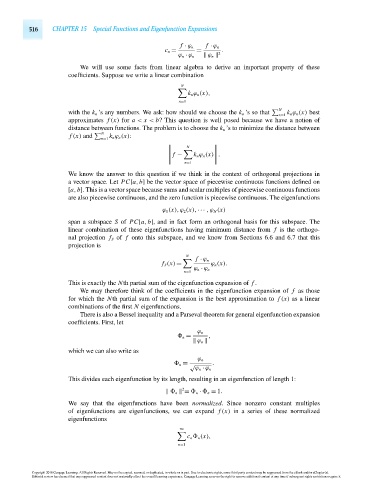Page 536 - Advanced_Engineering_Mathematics o'neil
P. 536
516 CHAPTER 15 Special Functions and Eigenfunction Expansions
f · ϕ n f · ϕ n
c n = = .
ϕ n · ϕ n ϕ n 2
We will use some facts from linear algebra to derive an important property of these
coefficients. Suppose we write a linear combination
N
k n ϕ n (x),
n=1
N
with the k n ’s any numbers. We ask: how should we choose the k n ’s so that n=1 k n ϕ n (x) best
approximates f (x) for a < x < b? This question is well posed because we have a notion of
distance between functions. The problem is to choose the k n ’s to minimize the distance between
N
f (x) and k n ϕ n (x):
n=1
N
f − k n ϕ n (x) .
n=1
We know the answer to this question if we think in the context of orthogonal projections in
a vector space. Let PC[a,b] be the vector space of piecewise continuous functions defined on
[a,b]. This is a vector space because sums and scalar multiples of piecewise continuous functions
are also piecewise continuous, and the zero function is piecewise continuous. The eigenfunctions
ϕ 1 (x),ϕ 2 (x),··· ,ϕ N (x)
span a subspace S of PC[a,b], and in fact form an orthogonal basis for this subspace. The
linear combination of these eigenfunctions having minimum distance from f is the orthogo-
nal projection f S of f onto this subspace, and we know from Sections 6.6 and 6.7 that this
projection is
N
f · ϕ n
f S (x) = ϕ n (x).
ϕ n · ϕ n
n=1
This is exactly the Nth partial sum of the eigenfunction expansion of f .
We may therefore think of the coefficients in the eigenfunction expansion of f as those
for which the Nth partial sum of the expansion is the best approximation to f (x) as a linear
combinations of the first N eigenfunctions.
There is also a Bessel inequality and a Parseval theorem for general eigenfunction expansion
coefficients. First, let
ϕ n
n = ,
ϕ n
which we can also write as
ϕ n
n = √ .
ϕ n · ϕ n
This divides each eigenfunction by its length, resulting in an eigenfunction of length 1:
2
n = n · n = 1.
We say that the eigenfunctions have been normalized. Since nonzero constant multiples
of eigenfunctions are eigenfunctions, we can expand f (x) in a series of these normalized
eigenfunctions
∞
c n n (x),
n=1
Copyright 2010 Cengage Learning. All Rights Reserved. May not be copied, scanned, or duplicated, in whole or in part. Due to electronic rights, some third party content may be suppressed from the eBook and/or eChapter(s).
Editorial review has deemed that any suppressed content does not materially affect the overall learning experience. Cengage Learning reserves the right to remove additional content at any time if subsequent rights restrictions require it.
October 14, 2010 15:20 THM/NEIL Page-516 27410_15_ch15_p505-562

